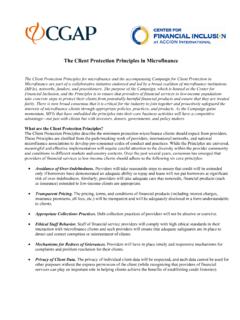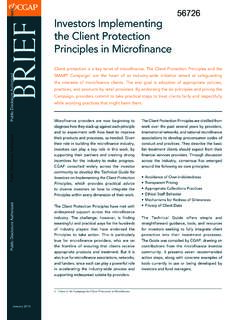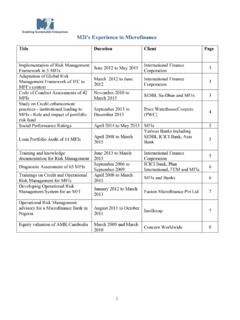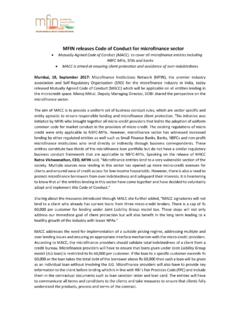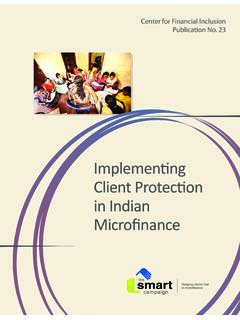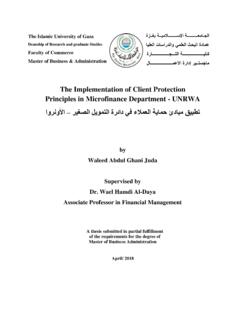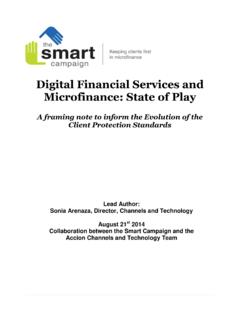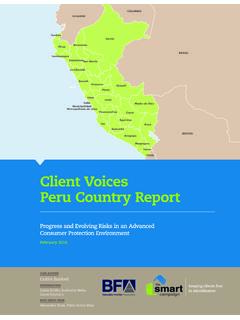Transcription of Policy brief no.7 - November 20111 - United Nations
1 Table 1: microfinance Institutions in Sub-Saharan Africa, Outreach in 2008 BorrowersLoanPortfolioDepositorsDeposits thousandsMil USDthousandsMil USDSub- SaharanAfrica7,7714,70021,5825,200 Central Africa3741,033 Eastern Africa4,51911,806 SouthernAfrica1,1212,171 Western Africa1,7576,571 Source: MIX and CGAP (2011): Sub- Saharan Africa 20 10 microfinance Analysis and Benchmarking ReportOnly 12 percent of households in Sub-Saharan Africa have deposit accounts in formal financial institutions2. This is by far the lowest share of banked households in any region in the world. Yet access to savings, credit, insurance, payments and other financial services play a vital role in enabling households to cope with financial shocks and protect and build their assets. Financial inclusion is defined by the OECD as the process of promoting affordable, timely and adequate access to a range of regulated financial products and services and broadening their use by all segments of society through the implementation of tailored existing and innovative approaches including financial awareness and education with a view to promote financial wellbeing as well as economic and social inclusion.
2 microfinance , which focuses specifically on poor and low incom e clients , is at the core of any financial inclusion strategy, but must be seen within thebroader financial system. The challenge for Africa is to expand access, while ensuring that such access is accompanied by proportionate regulation, supervision and education to safeguard the security and stability of the financial system aswell as protect and empower consumers and brief - November 20111 The financial sector in Africa is characterized by a number of weaknesses small size, lack of financial depth, a high degree of informality, regulatorydeficiencies that impact negatively on the provision of microfinance services. Continent-wide there are only 163 deposit accounts and 258 loan accounts in commercial banks per1,000 adults compared to 737 and 258, respectively, for developing countries as a whole. On average, there are only 3 bank branches and 5 AutomatedTeller Machines (ATMs ) available per 100,000 adults on the continent, compared to 10 branches and 29 ATMs for the developing world as a document is part of a series of Policy briefs produced by the United Nations Office of the Special Advisor on Africa (OSAA) and the NEPAD-OECD Africa Investment Initiative for African policymakers and their development partners.
3 The Policy briefs provide an overview of key economic and development issues affecting Africa today. The Policy brief on microfinance was prepared in cooperation with the United Nations Capital Development Fund(UNCDF). The briefs are available at , and at tment/Africa. For more information, please contact: David Mehdi Hamam, Chief (OSAA) at Karim Dahou, Executive Manager (NEPAD-OECD Initiative) at the overall low level of penetration in the region, the region is experiencing relatively high growth rates, with the number of borrowers increasing by 20% over the previous year to million and the number of savers increasing 30% to million. The volume of deposits also exceeds that of borrowing, at $ billion and $ billion respectively. [FN: MIX and CGAP: MIX microfinance World: Sub-Saharan Africa MicrofinanceAnalysis and Benchmarking Report 2010.]
4 Washington, April 2011.] The robust growth in savings in the region during the economic crisis has only gainedmomentum and allows the region to reduce itsdependence on cross-border funding and maintain arelatively low cost of market structure in terms of financial serviceproviders has changed substantially in recent years, withbanks experiencing high growth rates in both borrowers and depositors from initially low levels. microfinance continues to be delivered through a range of institutional types, with credit unions/cooperatives predominating in West and CentralAfrica, non-bank financial institutions predominating in East Africa, and banks dominating in Southern Africa. NGOs continue to play an important role throughout the region, particularly in terms ofborrowers (18% of borrowers), while reaching only 8% of savers which is not surprising given regulations regarding dominance of savings reflects the significant role that banks and credit unions play in the microfinance sector in Africa.
5 Non-deposit taking financial institutions reach a comparable number of clients as borrowers, but even there the average size of a loan from a non-deposit taking institution is much smaller than that of a bank or credit union. Because of the limited dependence of the sector on external and donor flows, African MFIs were less vulnerable to the global financial crisis and the temporary drought of financial flows in 2008 and weathered the storm relatively analysis of other financial services reveals a similar picture. A study by ILO found that million Africans were covered by microinsurance, which is a mere percent of the estimatedpotential target population5. Given that the financial risks that pose the greatest threat to household financial security as perceived by clients themselves are insurable events such as theft, fire, and destruction of property, serious illness or accident of a household member, and death and related funeral expense6, increased access to these services could have a significant impact on the people, like everyone else, also need convenient, safe, and efficient ways of making payments.
6 Technological advances such as the use of mobile technology can facilitate transactions and lower financial, transaction, and opportunity costs, particularly to people living in more remote, less densely populated areas that are expensive to serve (see Box on M-PESA). Mobile banking services are or soon will be available in 28 countries, with Kenya and South Africa as the pioneers4. Much can be done to support development and extension of these services as well as ensure that regulators take an approach of test and learn that allows for innovation and develops regulation as tested approaches become ready for scale up and/or Challenges and OpportunitiesThe triple food, fuel, and financial shocks in 2008 reminds us that financial access must be accompaniedby appropriate prudential regulations and market conduct ( you could make reference here to the G20 principles on financial consumer protection developed M-PESA and M-KESHO The Promise of Mobile BankingKenya has witnessed the world s most rapid growth of the use of mobile money.)
7 The mobile -phone based payment and money transferservice known as M-PESA was launched in 2007 and has spread extremely quickly to service more than 13 million customers by the end of 2010. M-PESA s success has allowed theprovider, Safaricom, to e xpand its range ofservices and offer a range of innovative financial products based on mobile phone can now earn moderate interest on mobile bank accounts, while farmers can insure their crops against adverse weather conditions and payouts are made directly to their phones if weather conditions indicate crop , through a partnership betweenSafaricom and EquityBank called M-KESHO, clients now also have access to savingsaccounts, using mobile transactions to depositand withdraw : Jack, William and Tavneet Suri (2011): Mobile Money. NBER Working paper 167213 Figure 1: Consumer protection Legislation and Implementation47564665507637564260594442 5483425067553133385048 Sub-SaharanAfricaEast Asiaand PacificSouth Asia Europe andCentral AsiaMiddle Eastand NorthAfricaLatinAmericaandCarribbeanPerc entage of Economies withDesignated Consumer protection UnitPercentage of Economies with at leastOne Recourse Mechanism with a ThirdParty for Bank and MFI ClientsAverage Extent of DisclosureRequirments by Banks and MFIs toClients at Account Opening Percentage of Fair Treatment PracticesImplemented by Banks and MFIsSource: CGAP / World Bank (2010): Financial Access 2010.
8 Washington or do not have appropriate protections and recourse (such as commercial courts) to facilitate a robust financial sector. This limited supervision capacity is further strained by requirements for implementation of anti -money laundering and counter-terrorismfinancing (AML/CTF) requirements that have someunintended consequences of limiting access to financial services8. Central banks and governments shouldapproach regulation and supervision seeking a balance between access and stability and security and taking into consideration their capacity to implement and the proportionate risks to the financial system. Because they have fewer assets and resources andhave less access to information, poor and low income clients are particularly vulnerable to financial shocks and crises, as well as inappropriate treatment byfinancial services providers. Policymakers and otherstakeholders have seen the fallout from crises in the sector in other countries (for example, over-indebtedness in Morocco, Bosnia-Herzegovina,Pakistan and Nicaragua, and the repayment crisis in Andhra Pradesh in India).
9 As a result, client protection is has become a central theme in industry efforts to self-regulate as well as in Policy makers actions to ensure that expanded access to finance is to fair and transparent services. Yet at present, Sub-SaharanAfrica is still lagging behind other regions in bothconsumer protection legislation and implementation(see Figure 1).under the aegis of the OECD together with the FSB andother relevant international institutions)that can,amongst other things, mitigate the impact on the governments are increasingly includingmicrofinance in their regulatory framework, whether as part of banking legislation, non-banking financialinstitution legislation, or , the OECD together with the FSB and other relevant financial institutions, developedprinciples on financial consumer protection , endorsedby the G20, whichdemonstrate the global trendstowards increased financial consumer protection and market conduct.
10 Despite progress in recent years,however, weaknesses and gaps remain at the micro-,industry- and macro-levels. Many countries lackregulations that adjust the regulation in proportion to the systemic risks posed by the scope and type ofactivities. Some countries do not adequately regulate and supervise all financial services providers,andfinancial cooperatives may still be regulated bygenerally cooperative authorities rather than byspecialized financial regulators. Reporting andaccounting standards are being improved, though there is a need to accelerate capacity for supervision of the microfinance sector continues to lag behind. In order to address thiscapacity constraint, central banks in some countries regulate only deposit-taking institutions, while theministry of finance or other ministries supervise non-deposit taking entities.










